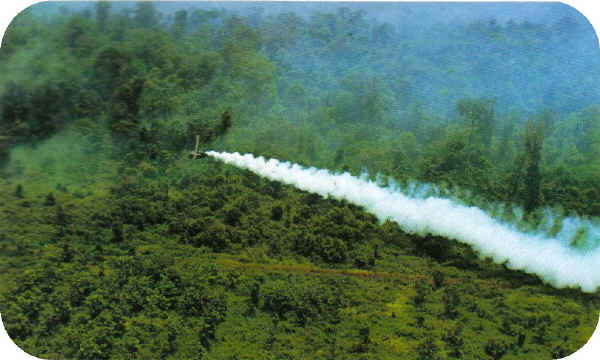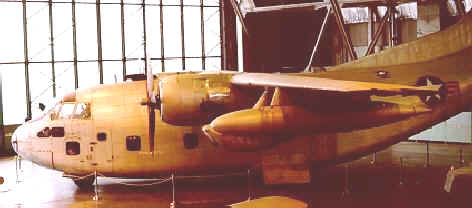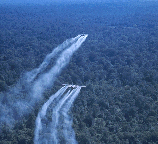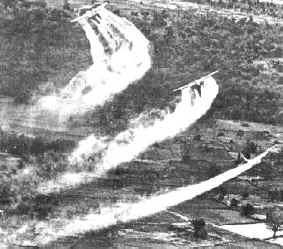 |
| Category:
Conflicts/Vietnam |

|
|
|
|
|
|
Agent Orange and
other chemicals |
 |
| A light
plane sprays some of the 19 million gallons of defoliant used in Viet
Nam. Each plane could destroy 350 acres of forest per run. A spray run
took less than 4 minutes, used 1,000 gallons of Agent Orange and was
often sprayed by 3 planes flying side by side. That meant 1 run equaled
1,000 acres of jungle destroyed. |
- Nothing about the most
controversial war in our history created more discussion than the
use of chemicals.
- Mostly the were used as defoliants
in an attempt to make the jungle less dangerous to Allied soldiers
and less of a refuge to Victor Charles. It didn't work very well and
the cost is immeasurable.
- The other use of large quantities
of chemicals was in insect control.
- There is a very strong feeling
amongst veterans that huge medical problems have resulted for
themselves and their descendents.
|
 |
"Patches", The
Air Force C-123 that took the most ground fire of any aircraft flying
herbicide missions in Vietnam (U.S. Air force
Photo) |
| What is it and
why use it?
Agent Orange was the code name for a
herbicide developed for the military, primarily for use in tropical
climates. Although the genesis of the product goes back to the 1940's,
serious testing for military applications did not begin until the early
1960's.
The purpose of the product was to deny
an enemy cover and concealment in dense terrain by defoliating trees and
shrubbery where the enemy could hide. The product "Agent
Orange" (a code name for the orange band that was used to mark the
drums it was stored in, was principally effective against broad-leaf
foliage, such as the dense jungle-like terrain found in Southeast Asia.
 The
product was tested in Vietnam in the early 1960's, and brought into ever
widening use during the height of the war (1967-68), though it's use was
diminished and eventually discontinued in 1971. The
product was tested in Vietnam in the early 1960's, and brought into ever
widening use during the height of the war (1967-68), though it's use was
diminished and eventually discontinued in 1971.
Agent Orange was a 50-50 mix of two
chemicals, known conventionally as 2,4,D and 2,4,5,T. The combined
product was mixed with kerosene or diesel fuel and dispersed by
aircraft, vehicle, and hand spraying.
An estimated 19 million gallons of
Agent Orange were used in South Vietnam during the war.
The earliest health concerns about Agent
Orange were about the product's contamination with TCDD, or dioxin. TCDD
is one of a family of dioxins, some found in nature, and are cousins of
the dibenzofurans and pcb's.
The TCDD found in Agent Orange is
thought to be harmful to man. In laboratory tests on animals, TCDD has
caused a wide variety of diseases, many of them fatal. TCDD is not found
in nature, but rather is a man-made and always unwanted byproduct of the
chemical manufacturing process. The Agent Orange used in Vietnam was
later found to be extremely contaminated with TCDD.
The Fifteen Herbicides
Used in Vietnam
- PURPLE: A
formulation of 2,4,-D and 2,4,5,-T used between 1962 and 1964.
- GREEN:
Contained 2,4,5-T and was used 1962-1964.
- PINK: Contained
2,4,5-T and was used 1962-1964.
- ORANGE: A
formulation of 2,4,-D and 2,4,5-T used between 1965 and 1970.
- WHITE: A
formulation of Picloram and 2,4,-D.
- BLUE: Contained
cacodylic acid.
- ORANGE II:
A formulation of 2,4,-D and 2,4,5-T used in 1968 and 1969 (also
sometimes referred to as "Super Orange")
- DINOXOL:
A formulation of 2,4,-D and 2,4,,5-T. Small quantities were tested
in Vietnam between 1962 and 1964.
- TRINOXOL:
Contained 2,4,5-T. Small quantities tested in Vietnam 1962-1964.
- BROMACIL
- DIQUAT:
- TANDEX:
- MONURON:
- DIURON:
- DALAPON:
Small quantities of all of the above
were tested in Vietnam, 1962-1964.

|
| The
Question & Answer section below is from an American public service
site. |
What was Agent
Orange?
Agent Orange was a herbicide developed for military use. Chemically, the
product was a 50/50 mix of two herbicides, 2,4,-D (2,4,
dichlorophenoxyacetic acid) and 2,4,5-T (2,4,5 trichlorophenoxyacetic
acid). These herbicides were both developed as weed killers in the
1940's, and were effective against broad leaf plants and several crops.
Why did the military use
herbicides?
Herbicides were developed to be deployed in enemy areas to deny cover
and concealment to the enemy. In dense terrain particularly, the use of
herbicides to destroy covering vegetation was to protect American and
allied troops from ambush or other undetected movement of the enemy.
Prior to it's introduction for
use in Vietnam, was Agent Orange used in the United States?
Yes. During the testing phase of Agent Orange, use tests were
carried out at Fort Detrick, Maryland, Eglin Air Force Base in Florida,
and Camp Drum in New York. Other testing was also conducted in Thailand
in the early 1960's.
Why was the product called Agent
Orange?
The name signifies orange identifying bands that were used on the
fifty-five gallon drums the product was shipped in. Other herbicides
were also used in Vietnam, and were known by color coded names too, such
Agent White, Agent Blue, Agent Purple, Agent Pink and Agent Green were
also used.
Who were the manufacturers who
produced Agent Orange for the military?
Dow, Monsanto, Diamond Shamrock Corporation, Hercules Inc., Uniroyal
Inc., T-H Agricultural & Nutrition Company, and Thompson Chemicals
Corporation. These companies were subjects of a class action lawsuit
filed originally in 1979 and settled out of court in 1987 for $180
million. The official name of the lawsuit was Multidistrict litigation
381 (MDL 381), and was designated In re Agent Orange Product Liability
Litigation.
I want (or I had) an "Agent
Orange Test", sometimes thought to be given by the VA -- What is
this?
There is no such thing as an Agent Orange Test. This is often
confused with two things:
1. The Agent Orange screening physical given at VA
Medical Centers: This test is nothing more that a general physical which
includes examination, X-rays and blood work. It does not detect Agent
Orange exposure. This physical is useful only as any routine physical is
useful in early detection of disease or health problems. The VA does
keep these results in a registry.
2. Dioxin analysis of the blood or fatty tissue: There
are sophisticated tests which will measure dioxin levels in both blood
and fatty tissues. (Dioxin is the unwanted byproduct in Agent Orange).
These tests are research-oriented only, and have never been available on
a large-scale or clinical basis. The VA does not perform these tests.
Only a few laboratories in the world are able to do this testing, and it
is usually quite expensive, around $1500-$2000 per test.
Can I sue the government or the
chemical companies?
No. Title 38 of the United States Code prohibits veterans from suing the
government for injuries suffered while in the military. A class action
suit was filed in behalf of veterans in 1979 against the chemical
companies and settled out of court. The final funds in this legal action
were distributed by 1992. Additional attempts to sue the manufacturers
have been attempted, and have been prohibited by the courts. The most
strongly fought of these legal battles, Ivy vs. Diamond Shamrock was
supported in behalf of the plaintiff by attorney generals in all fifty
states, the Supreme Court, however, refused to hear the arguments and
that case ended in 1992. In the parlance of the court, the issue is
"res judicata" or "the matter is settled". |
|